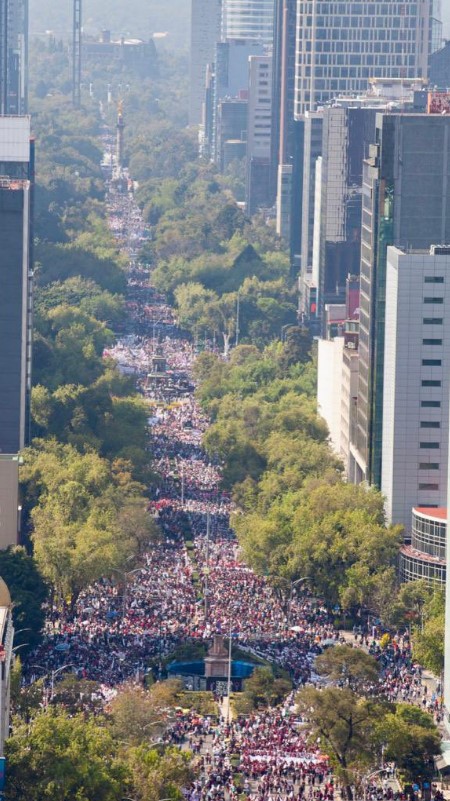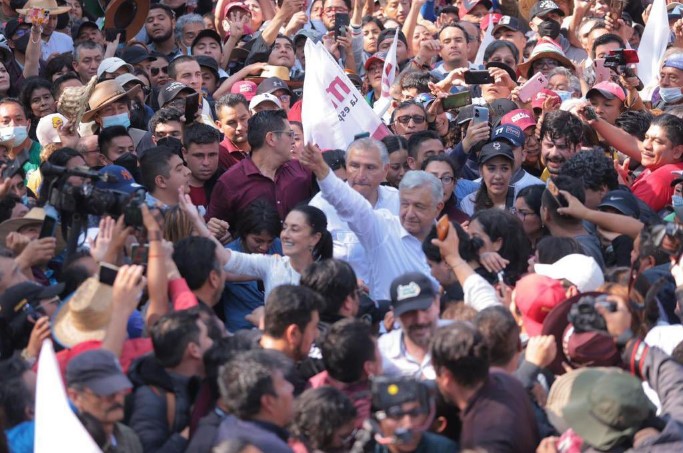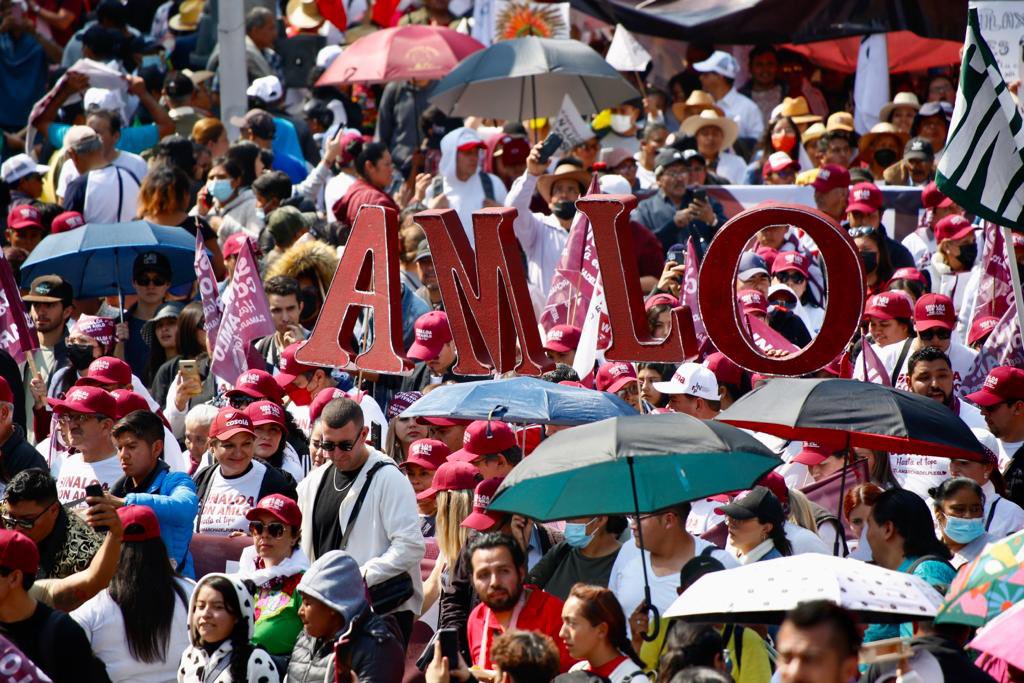1,200,000 people flooded the streets of Mexico City, according to government figures. The given figure does not seem to be an exaggeration. People from all over the country, and even Mexican migrants living in the US, gathered in the country's capital in response to Andrés Manuel López Obrador's call for a march on the fourth anniversary of his taking office.
It was a powerful show of strength by the Mexican people. The demonstration had a clear popular character. On the streets you could see workers, people from poor villages, indigenous people and also sectors of the petty bourgeoisie.
Electoral reform and the actions of the right wing
López Obrador's government is pushing for an electoral reform that includes, among other things, that the members of the National Electoral Institute (INE) and the magistrates of the Electoral Tribunal be elected by universal suffrage, and reducing the million-dollar budget that political parties receive. Although the parties allied to the government of Obrador’s so-called Fourth Transformation (4T) have a majority in the parliamentary chambers, after the 2021 elections, they lost the supermajority (two-thirds) needed to make constitutional changes. This has given some power to the weak opposition to block some initiatives, as they are now doing with the electoral reform.
The right wing has unleashed a rabid campaign, claiming that AMLO wants to eliminate the INE in order to supposedly establish a dictatorship. With these false arguments they have finally managed to capitalise on the discontent of a minority sector of the population that opposes this government. They called for a mobilisation on 13 November, which in Mexico City brought together some 50-60,000 people, and a few thousand more in local marches in different cities around the country.
The march on 13N is the first unified mobilisation of the right wing to come out with any real strength in this six-year term. The reality is that the traditional parties are in crisis, they have seen their base eroded and have had to establish an unprincipled alliance among themselves, including the National Action Party (PAN), Party of the Democratic Revolution (PRD) and Institutional Revolutionary Party (PRI). They look like a bunch of drunks who have to hug each other to keep from falling, but with the danger that they might all fall down together. In addition, during this six-year term, we have seen the birth of weak right-wing groups like the National Anti-AMLO Front (FRENA) and some others that criticise the “progressivism” of the current government, but do not feel identified with the old bourgeois parties that have already been discredited. The right wing finally managed to attract a section of the population on 13N, mainly disillusioned sectors of the petty bourgeoisie. After the relative success of their march they were emboldened, trying to go on the offensive. But the march on 27 November called by AMLO was the withering response of the masses against them.
The forceful response of the masses
AMLO had originally called for a rally on Thursday 1 December, which is the exact date of the anniversary of his inauguration as president. But he preferred to change the day, firstly to ensure a larger turnout on a Sunday and, secondly, that instead of a rally it would be a march. This call encouraged the masses, who saw the opportunity to respond to the right wing.
 AMLO's call encouraged the masses, who saw the opportunity to respond to the right wing / Image: Claudiashein
AMLO's call encouraged the masses, who saw the opportunity to respond to the right wing / Image: Claudiashein
The traditional bourgeois media, the intellectuals of the old regime at the service of the bourgeoisie, journalists critical of the current government, etc. began a campaign to say that those who would attend would be acarreados, people mobilised by local politicians, without any political convictions, and having been paid to attend. The 27N march was full of banners and slogans mocking this claim, making it clear that they were attending of their own free will.
Today, given the strength of the mass action, it is said that it was a “state march”; that the only reason it was more successful than the “citizens' march” of 13 November was because the state media and the apparatus of the Morena government were put at its service. Morena and 4T officials undoubtedly act in a bureaucratic manner, and the march was a show of force by various bureaucrats and local groups. No doubt there was a degree of bureaucratic mobilisation, but the fundamental character was of people attending of their own free will and convictions.
Under previous administrations, a president could not appear openly in front of the population without receiving insults. It is clear that millions of workers in this country see this government as their own. Another thing that was very noticeable in the march on 27 November was that people defended measures such as student grants or pensions for the elderly that have been achieved under this government.
The march had been called to start at 9:00 in the morning, but since early morning, buses with contingents from all the states of the country had already begun to arrive. Although the march started from the Angel of Independence, the whole route from the National Auditorium (four kilometres back), Reforma Avenue and other avenues was crowded all the way to the Zócalo, where the march ended. Contingents marched through for five hours straight, similar to the time it took AMLO to get from the Angel of Independence to the Zócalo. The president planned to stand at the front with a dozen or so leaders, but the people crowded around him. AMLO said that the frontline of the march was actually the people themselves. People gathered around, trying to touch him, to take a selfie with him, to greet him or just to see him pass by.
AMLO was accompanied by three aspiring successors: Claudia Sheinbaum (head of government of the CDMX), Marcelo Ebrad (foreign minister) and Adán Augusto López (secretary of government). The one who was absent was Ricardo Monreal, leader of the Morena parliamentary faction in the Senate, who also has presidential aspirations but a long tradition of conciliation with the right and, not seeing internal support for a future presidential candidacy, has deepened his conciliation with right-wing parties. In the march of 27N, many demonstrations of rejection of Monreal were very noticeable.
What we saw on this 27N march was the response of the masses against the right wing and a show of sympathy and support for the government. This speaks of the real balance of forces, which is very favourable to the workers. However, the motivating factor, which is electoral reform, will be rejected, because parliament does not reflect the strength of the streets and continues to be an instrument of the ruling class, which has a thousand mechanisms to prevent progress towards profound change. Even this electoral reform, which is very moderate, will not be accepted. In the end, some more moderate changes will be made to the electoral regime, no longer by modifying the constitution but by passing certain laws, as happened a few months ago with energy reform. This is a clear reflection of the limits of trying to transform society within the framework of the state and the capitalist system itself, although there is plenty of potential to support such transformation with the mobilisation of the workers.
Right and left poles
The march called by the right wing on 13 November, although not massive, was an expression of the disillusionment of a sector of the petty bourgeoisie, reflecting the fact that the changes have not been able to solve fundamental problems. We have seen in other countries mass electoral support for the far right, in Mexico they have so far shown a lot of weakness. In the march of 13N we saw anti-worker/poor and racist sentiments expressed. A video went viral of a hysterical woman who said that AMLO had patas rajadas (“no manners”), and that not even putting on the best shoes could remove his naco (“low class and ignorant”) character. Hysterical reactionaries like this remain a tiny grouping for now.
On the left, we also see expressions of criticism towards the government. An example of this is that, days before, the workers of the Democratic Teachers' Union held a marathon march. For days, a group of teachers marched from Chilpancingo, Guerrero, to Mexico City, a distance of 275 kilometres. The education workers are demanding a dialogue to discuss various issues, including modification of the pension system to be more favourable. In the same state, the resistance of the parents of the 43 normalista (teacher training) students who disappeared on 26 September 2014 continues, and they have criticised the slow progress of the justice system, which still does not provide clear answers about the whereabouts of their children. What we see from the left is an expression of criticism that is not reactionary, but recognises the limits of the current government and continues to raise the banner of defending the interests of the working people.
4T policy is essentially about reforming the system, within the laws of capitalism. The measures of the current government have managed to alleviate some problems (for example by giving some economic support to poor families) but without resolving the contradictions of the system that continue to be expressed. World capitalism is in crisis and Mexico is not exempt from it. The capitalist system has tended to deteriorate the living conditions of the masses, while big capital continues to make huge profits. AMLO's government has not broken with this cycle and we see the big bankers and capitalists maintaining their millionaire profits.
AMLO enjoys enormous authority and his presence as president tends to prevent an open clash between the classes. But polarisation will develop, and when he is no longer in office, they will evolve further and further, and class conflict on the basis of irreconcilable interests will be inevitable.
Fundamental change must come from the organisation of workers.
López Obrador, arriving at the Zócalo after an exhausting march, still gave an hour-and-a-half speech in which he gave a report emphasising what he considers the achievements of his government. At one point, people shouted for him to be re-elected. That AMLO will remain in government has been a fear for the national and international bourgeoisie. The Mexican revolution that began in 1910 began as a struggle led by Francisco I. Madero against presidential re-election, and that tradition is still present. AMLO responded to the harangues that he was a Maderista and would not be re-elected, nor would his partner Beatriz Gutiérrez Müller aspire to any office. The way the masses acted is an expression that they do not have sufficient confidence in the president's possible successors.
 On the one hand, Obrador mobilises the masses, but on the other hand he does not call on them to go further / Image: Claudiashein
On the one hand, Obrador mobilises the masses, but on the other hand he does not call on them to go further / Image: Claudiashein
The strength of Sunday's mobilisation shows enormous potential for transformation, provided it is strategically based on the organisation and struggle of the workers. AMLO, however, continues to avoid confrontation with the capitalist class. He defined his government's philosophy as ‘Mexican humanism’ that seeks to promote progress through social justice. Capitalism cannot exist without class exploitation. Many before AMLO have sought to create a more humane capitalism, but have failed. An example of this was Hugo Chávez in Venezuela, who carried out more profound measures than the current Mexican government but in the end concluded that there was no middle or third way, and that the struggle had to advance towards socialism.
In Mexico, we see a balance of forces favourable to the workers, and a bourgeoisie that has economic power, but no solid social base and weak, crisis-ridden political parties. AMLO continues to give concessions to the workers. After this march he announced a 20 percent increase in the minimum wage. But he is also making concessions to the employers. On the one hand, he mobilises the masses, but on the other hand he does not call on them to go further, to take action and to advance their organisation. Just as in his speech in the Zócalo he talked about the ‘progressive wave’ in Latin America and greeted the victory of Lula da Silva in Brazil on the one hand, the other hand he talked about good neighbourliness with the USA and defined US president Joe Biden as a statesman (Watch here: (221) Speech of Andrés Manuel López Obrador in the Zócalo – YouTube).
Against bureaucracy: for grassroots organisation
In sum, the 27N march showed that the current government is sustained by large popular support, that an important sector of the organised population is ready to defend the gains achieved so far, to confront the right wing and to fight to deepen the process. But on 27N there was no call to strengthen the organisation of the working class or to take action to advance in the deepening of the transformation of society.
At the same time, in the last period we have seen a phenomenon of bureaucratisation of the Morena party, which has been taken under the almost absolute control of the bureaucracy and officials. Many pro-worker activists have gone to work in the party or government structures, even if they have criticisms about how the party is degenerating, many keep quiet for fear of losing their jobs. The bureaucracy is a fifth column, a brake to contain the organisation of the masses, to stop them in their tracks. This sector tends to conciliate with those who have opposed profound change in the country.
Another negative element that cannot be overlooked is the enormous power that the Secretariat of National Security is acquiring, which will not only increase the armed forces at its disposal, but also its political and even economic power (by becoming the owner of some of the current government's main public works projects).
Strategically, this government is relying on the state structures, which it is trying to reform, to seek economic development (within the limits of capitalism), while attempting to give some handouts to the masses, such as social programmes and some concessions such as an increase in the minimum wage (which will help to at least counteract the effects of inflation).
Millions have enormous confidence in AMLO, a non-corrupt president who does not have a policy of attacking workers as previous governments did. But the most-advanced sectors see that time is running out, that the changes are not going as far as required and that whoever succeeds AMLO is going to be more limited than he is.
The work of organising from the rank and file, of creating cadres through political training linked to the class struggle, of not abandoning the defence of the interests of the workers and the oppressed masses, remains the fundamental task.
AMLO has declared this year as the year of Ricardo Flores Magón. Magón began by defending a liberal ideal, fighting against corruption and for respect for the law, trying to reform the prevailing regime and system. But in the end he concluded that he had to fight against the capitalist system. If Ricardo remains relevant 100 years after his death, it is, on the one hand, because he died intransigently defending his ideas without betraying them and, secondly, because the injustices and the system he fought against are still present. The need to fight against capitalism is what maintains the true validity of this internationalist revolutionary born in Oaxaca. AMLO in his speech uttered a phrase he took from Ricardo Flores Magón: “Only the people can save the people”. It is necessary to strengthen the organisation and political education of the rank and file, fighting to deepen the process towards an anti-capitalist alternative.

